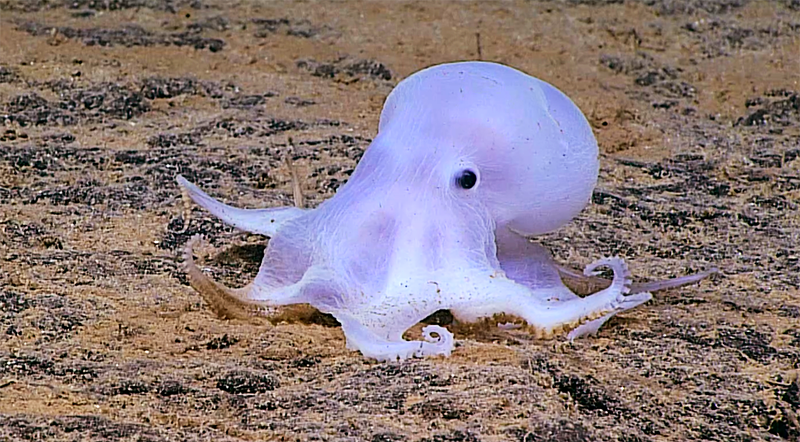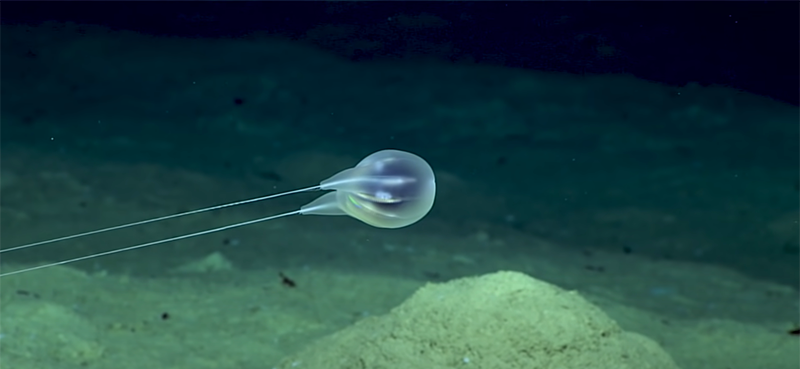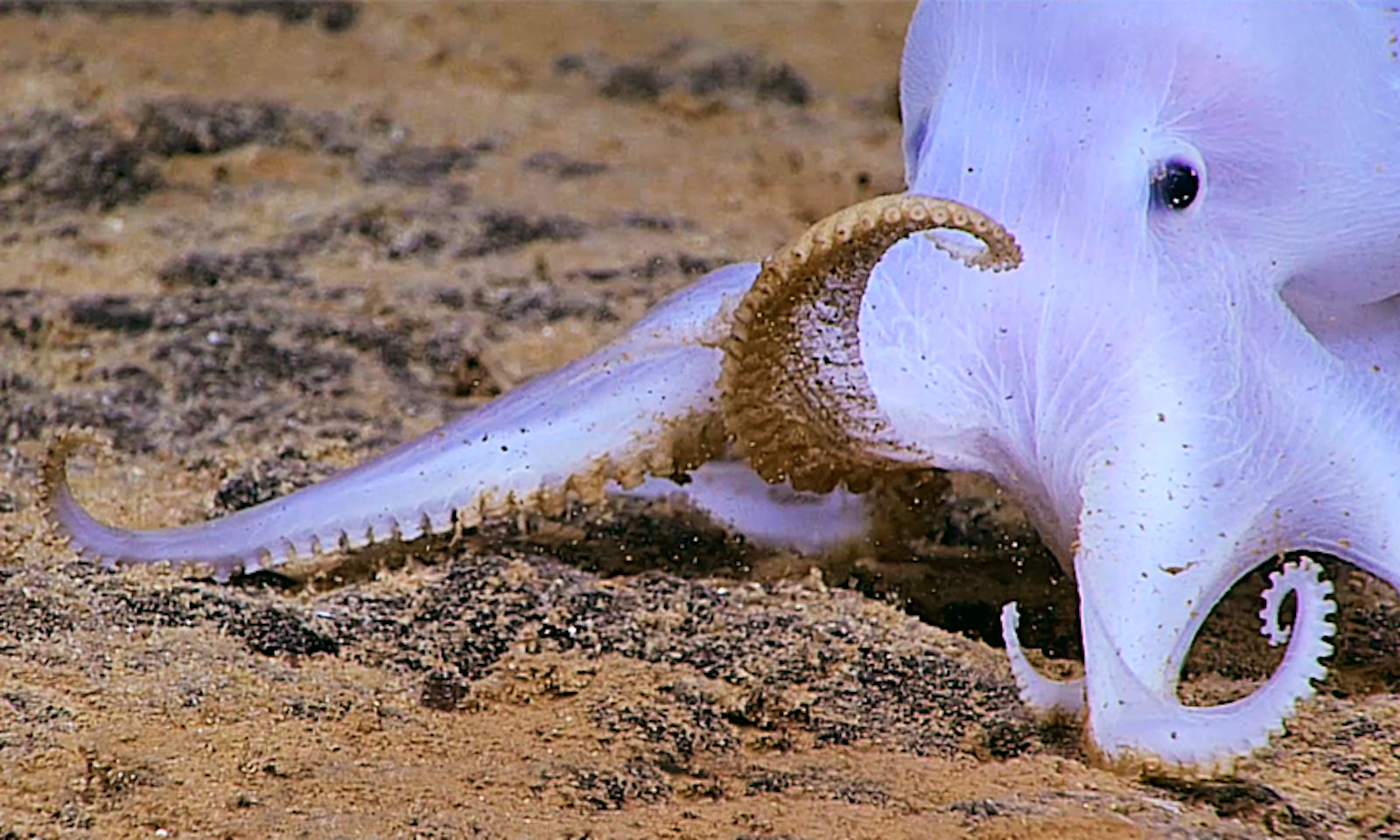On Feb. 27, 2016, a beam of light from the Deep Discoverer, an undersea exploration vehicle operated remotely by researchers, fell on something new: a pale octopus resting on a flat rock at the bottom of the ocean off the Hawaiian archipelago, more than two and a half miles below the ocean surface.
The octopus was alone, her arms drawn up under her body into a shape like a light bulb, an underwater Eureka moment.
“It didn’t match the descriptions of anything that I was familiar with,” says Michael Vecchione, a zoologist with the National Oceanic and Atmospheric Administration and the Smithsonian Institution, who was watching the Deep Discoverer’s live video feed from shore that day.
The animal lacked chromatophores, the pigmented cells that enable other octopuses to change color. Her skin was slack, her body appearing less muscular than the typical octopus. And she had only one row of suckers on the underside of her arms rather than the expected two. This was pretty clearly a creature new to science.
The animal’s ghostlike appearance gave rise to a charming if obvious nickname: “Casper octopus.” But seven years later the species still doesn’t have a formal scientific name.
The rules were written in another age, one of European conquest and colonialism.
Describing a new species has traditionally required a physical specimen, known as a holotype, that can be preserved in a museum and referenced in perpetuity: This is the creature we mean when we say this name. But no specimen of the Casper octopus has yet been collected, a fairly common circumstance for deep-sea creatures glimpsed on research video feeds.
Maybe it’s enough to know that these unusual and charismatic animals exist, going about their lives thousands of feet below the surface, unsnared by the net of scientific nomenclature.
But there’s this: The sea floor off the coast of Hawaii has a mineral crust that’s rich in iron and manganese, and similar octopods have been spotted among fields of manganese nodules off the coast of Peru. “Those types of octopods seem to be found in areas that are likely to get mined,” says Vecchione, and mining would obliterate their homes. And without a scientific name, it’s difficult to add the animals to a list of endangered species or activate other legal mechanisms to protect them. For want of one specimen, could an entire species be lost?

Situations like this are pushing deep-sea explorers to challenge the conventional approach to naming and describing biodiversity. The largest habitable biome on Earth, the deep sea is difficult and expensive to access; its life forms are often delicate, shy, or scarce, making specimen collecting logistically difficult. And increasingly, for many scientists, questions about the ethics of collecting in an age of extinction sit like a grain of sand inside the oyster shell of the mind.
“There’s a whole range of animals I can tell you that we’ve seen once,” says Alan Jamieson, a marine biologist at the University of Western Australia in Perth who studies deep-ocean life. When Jamieson and his team encounter a solitary, never-seen-before organism there, they don’t know how old or rare it might be, and are therefore hesitant to collect it. “I don’t see the point in doing something irresponsible just for the sake of doing it by the rules,” says Jamieson. “The rules have been written for other environments.”
The rules were also written in another age, one of European conquest and colonialism. Nations claimed dominance over the earth and its human and non-human inhabitants—and natural history was part of that effort. To fill a ship’s hold with newly discovered creatures killed for future cataloging was simply how it was done, but today it’s becoming uncomfortable to think that the first thing we might do after encountering the Casper octopus or another wondrous new being would be to end their life.
Some researchers are now exploring methods and technologies that make it possible to describe species without requiring a physical specimen. These methods could help overcome the logistical hurdles to collection in the deep sea, and also move beyond traditional notions of scientific dominion over nature. They offer the first soundings of a scientific world in which we need not kill deep-sea creatures in order to know them.
Some time in 2015, Allen Collins, another NOAA/Smithsonian Institution marine biologist, opened a link to a screengrab from a different Deep Discoverer expedition, this one nearly 13,000 feet below the surface off the coast of Puerto Rico. Collins no longer remembers who sent him the link, but he does remember his reaction to what he saw there: “I thought, holy cow, that’s a cool thing,” he recalls.
The cool thing was a comb jelly, or ctenophore, a member of an ancient lineage of jellyfish-like animals who move by beating rows of giant cilia, or combs, along their bodies. This particular creature had the zaftig, water balloon-like body typical of ctenophores. But they also had two drumstick-like protrusions on their underside, giving them the appearance of a semi-translucent roast turkey, and from these protrusions sprouted a pair of long tentacles.
To say with certainty what a creature is based on a photograph or video can be fraught.
Collins and his colleagues decided to track down high-resolution videos from the dive and see how much scientific knowledge they could filter from the frames. They didn’t necessarily intend to formally describe the creature, Collins says, but they soon realized the video evidence could satisfy two key aims of species description: demonstrating how an organism is different from all others described before, and enabling other people to recognize the organism when one is encountered again. No physical specimen was necessary.
Partly this was down to luck. The Deep Discoverer captured three videos of the unusual ctenophore, and in one of them the creature is tethered to the sea floor by their tentacles, like the strings of a balloon in the Macy’s Thanksgiving Day Parade, holding the animal still for an extended close-up shot.
The researchers could count the combs of cilia on the animal’s body, and see eggs inside. “There was a lot of really high-precision detail that we were able to pull out,” Collins says. The result: the species description of Duobrachium sparksae, published in 2020. The holotype that defines the new ctenophore is not a specimen in a jar but a video on a server. Duobrachium sparksae hasn’t been seen since.

Contrast that with the situation of the Casper octopus. Scientists have encountered them several times—and at such disparate locations that Vecchione suspects there may be not just a species but a whole family of ghostly octopods—but they have not been formally described. Vecchione remains reluctant to base a species description on a video, and is still waiting for a specimen. Or, perhaps, for the threat of mining to loom large enough to overwhelm his reticence to proceed without one.
That reticence doesn’t come out of nowhere. Whether species ought to be formally described without a physical specimen has been a subject of ongoing debate among taxonomists since the mid-2010s, when researchers described two species of fly from photographs. To say with certainty what a creature is based on a photograph or video can be fraught, as anyone who has followed the sagas of the ivory-billed woodpecker or the Tasmanian tiger knows.
On the other hand, in some cases specimens are near-impossible to collect or preserve, or it’s widely considered unethical to do so; for the past several decades, new species of primates have been described without a killed specimen, as have several species of birds. The official position of the International Commission of Zoological Nomenclature: Species descriptions without specimens are allowed in certain limited cases, though it’s still frowned upon by many taxonomists.
“I always feel bad for the thing that’s being collected.”
The characteristics of ctenophores may have made D. sparksae a relatively easy lift in this regard. “Ctenophores are notoriously bad at preserving,” says Nicholas Bezio, a graduate student at the University of Maryland, who made the drawings for the D. sparksae species description as an intern at the Smithsonian.
Many ctenophore specimens in the Smithsonian’s collection amount to “a layer of jelly at the bottom of the container,” Bezio found in a recent comprehensive review of the museum’s comb jellies, and such difficulties aren’t limited to invertebrates. Snailfish—tiny top predators of the abyss—don’t take kindly to pickling either. “When you preserve them, they shrivel up,” says Jamieson. “When you go to look at it, you can barely take it out of the jar because its skin falls off.”
Dramatic pressure differences between the deep sea and the surface world, and the gelatinous nature of many deep-sea organisms, mean that many specimens—if they can be preserved at all—don’t look much like they did in life. If natural history museums are filled with row upon row of deep-sea specimens who, for their intended purpose, might as well not exist, what is a specimen, anyway?
Still, there are blank spaces in the knowledge of D. sparksae. Without a DNA sample, for example, scientists are unable to place them on the ctenophore phylogenetic tree. Certain aspects of the creature’s internal anatomy remain a mystery. And dotted lines in some drawings in the species description paper indicate features that couldn’t be clearly seen on the video.
For these and other reasons, most researchers say physical specimens are still an important part of understanding deep-sea biodiversity. If such a specimen is available, “I definitely think that’s the way to go” when it comes to new species descriptions, says Heather Bracken-Grissom, a marine biologist at Florida International University in Biscayne Bay.
Bracken-Grissom studies deep-water shrimp, a group in which the features that distinguish one species from another often have an angels-on-the-head-of-a-pin quality: the number of spines on the tail fan, the tooth-like points on the top of the rostrum, the presence or absence of a ridge on the carapace. Such structures tend to be too small and delicate to be seen on even high-resolution video and require the aid of a dissecting microscope.

Sometimes even the microscope is not enough, and Bracken-Grissom works by touch. “I will just take my finger and I’ll run it along the ridge,” she says. “It’s a lot easier to feel some of the characters than to see them.” Working with specimens can involve a surprising tenderness and intimacy.
But it’s intimacy, too, that raises discomfort with specimen collecting. Scientists on the late-19th century Challenger expedition collected marine life from around the globe via 133 bottom dredges and 129 open-water trawls; by the time anyone at the surface glimpsed these new-to-science life forms, many of them were already dead. But today, deep-sea expeditions often live-stream footage from remote operated vehicle (ROV) dives, both democratizing biodiversity science and implicating the public in its ethics.
“I always feel bad for the thing that’s being collected,” says Dolly Jørgensen, an environmental historian at the University of Stavanger in Norway. Jørgensen, who describes herself as “a big fan” of Okeanos Explorer, the NOAA ship from which the Deep Discoverer is launched, often streams mission footage at home. Technology “makes visible to even everyday viewers things that were completely invisible to us until very recently,” she says: the habitats of and interactions between deep-sea organisms, as well as the killing involved in collecting them for the sake of science.
It’s a dynamic that Vecchione is keenly aware of. If a Casper octopus were to be collected on a future ROV dive, he suspects, “there would be hell to pay” in the public comment section of the livestream.
As for Bracken-Grissom, thinking more about the difficulties of collecting and preserving some organisms has softened her intellectual carapace. “I can see the benefit now,” she says of efforts at species description in the absence of physical specimens. “I would rather see those things described than not.”
In the not-too-distant future, new technologies may offer more ways out of these dilemmas. Several approaches under development by researchers could allow the study of deep-sea animals in much greater, more rigorous detail than is possible with even the most high-definition video, while also leaving the creatures unharmed and in their natural environment.
For example, a new laser scanning technique can capture exquisitely detailed 3-D images, much like a CT scan or an MRI, of living organisms in the water. Researchers have used this technology to map the architecture of delicate mucus houses built by tadpole-like animals called larvaceans, structures they had been unable to study in the lab. The method “works really well for transparent or nearly transparent objects,” making it especially good for studying exactly the sort of gelatinous organisms that are difficult to collect and preserve, says Kakani Katija, a bioengineer at the Monterey Bay Aquarium Research Institute and one of the technique’s developers.
Other researchers have developed robotic instruments to interact with delicate marine creatures. One such device, a “hand” with six blue, noodle-like fingers, can grasp even small jellyfish without harming them. The interaction causes minimal stress to the animal, researchers have shown, and allows collecting DNA samples for studying their genome or other aspects of physiology. Another gentle robot, an origami-like structure known as a rotary-actuated dodecahedron, can fold up around an animal, temporarily capturing but not touching them.
Such devices could be bundled into a suite of tools for assembling “digital holotypes” that could provide a noninvasive approach to describing deep-sea biodiversity. The aim is to collect “a lot of information that one wouldn’t even be able to get from an actual physical specimen,” says David Gruber, a marine biologist at Baruch College at the City University of New York. Gruber, who says he has “always struggled” with the scientific imperative to sacrifice creatures’ lives for the sake of knowledge, has helped develop gentle robots and, along with Katija, is part of the team working on the digital holotype project.
Gruber’s comments make me think of a video of the Casper octopus taken off Hawaii during that February 2016 dive. In it, the animal undulates her arms and fixes the camera with a black button eye as she slowly backs away, a choreography that seems essential to her being but impossible to hold in a jar on a museum shelf.
If a future ROV equipped with instruments for collecting digital holotypes were to encounter a Casper octopus, a laser scan might capture the creature’s movements. The laser might also scan their external anatomy, inscribing the shape, size, and features of arms and suckers—characteristics often used to identify octopus species—in a digital file for researchers to study later and perhaps replicate via 3-D printing.
Octopuses are notoriously wary creatures, but maybe a robotic chamber attached to the ROV would manage to enfold the animals and hold them for a handful of minutes while sensors in the chamber tracked oxygen consumption, yielding clues about metabolism in the deep sea’s extreme conditions. A soft robotic hand might stretch out a finger equipped with a swab and stroke the animals’ skin, gathering cells for DNA analysis and delivering a kind of remotely operated benediction from the human species before sending the creatures on their way.
“We’re not fully there,” Gruber says of digital holotypes. But: “I think we’re really close now,” he says, as though peering just beyond the beam of light cast by a submersible, already imagining what might soon come into view. ![]()
Lead image courtesy of NOAA Ocean Exploration, 2016 Hohonu Moana






































